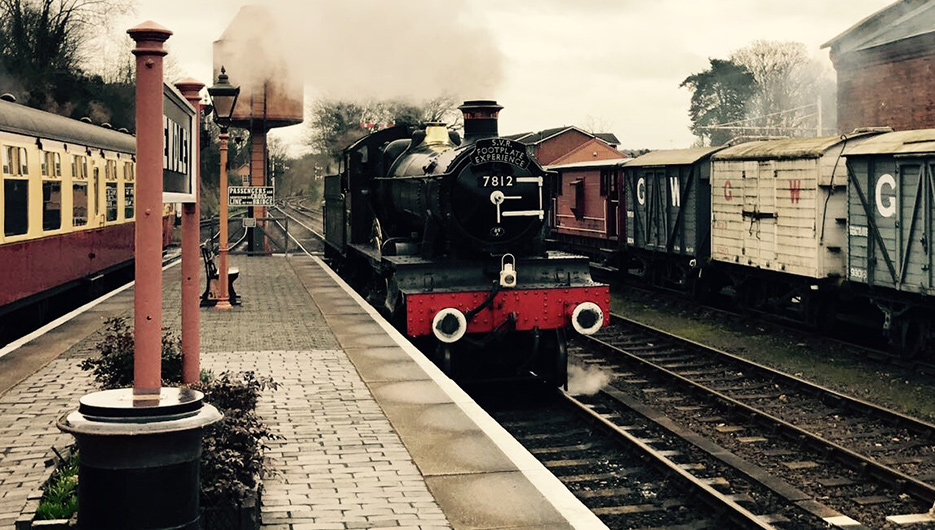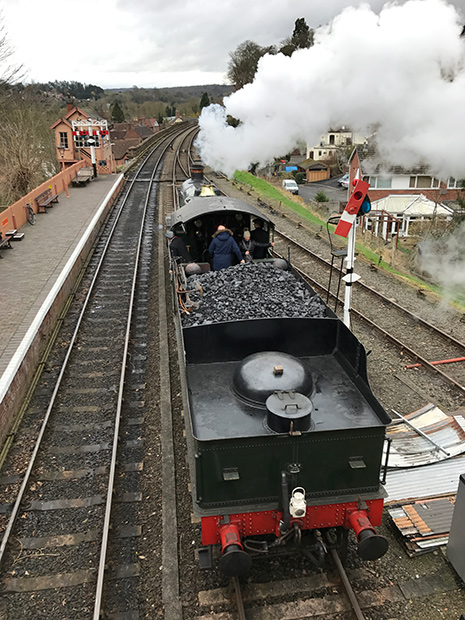Erlestoke Manor Footplate Experience
Earlier this year Anthony Endsor attended one of the SVR’s Footplate Experience’s. Anthony’s footplate experience was conducted on our very own 7812 Erlestoke Manor. He has very kindly written an article on his experience at the controls of Erlestoke Manor which provide a good insight into this fantastic experience available to enthusiasts who have always wanted to have a go on s real full size steam engine. If you already fancy the idea of getting behind the controls of a steam locomotive or want to try you hand and firing one please visit the SVR footplate experience web page for more information. But before you do, have a read about Anthony’s experience in his own words……….
This year, I turned 30. That perhaps seems very young or very old depending on which side of that age you fall. To mark the occasion, my fiancée had colluded with friends and family to book me onto the first Introductory Footplate Experience of 2017. I did well, my Grandfather waited until his 60th to get behind the controls of Castle Class Defiant at Tyseley. The SVR advised the secretive group when booking that it was likely to be a Manor used, but of course there are no guarantees and other locos are used. After the thrill of receiving such an incredible gift, I didn’t want to get my hopes too high, and certainly did not want to seem ungrateful or disappointed if it had been the Ivatt Class 4 or any of the tank engines that were rolled out on the day, but let’s face it, the Manors are that bit more special, all the more so if you are a member of the EMF.
The week prior to the experience was to be a busy week at the SVR with school half-term and a full time-table for 9 consecutive days, and also meant the rosters covering 18th February – 3rd March were published online. Again, not wanting to get excited, it was provisionally stated that 7802 Bradley Manor would be the engine designated for the Footplate Experience, but when the SVR’s DMU failed early in the week, it was 7802 that stepped up to the task, and with a revised schedule and some shift swapping with Erlestoke and the freshly rebuilt Pannier Tank 7714, 7802 was crossed off and replaced with 7812. Getting towards the weekend, there were further changes to the schedule with Bradley picking up more of the work that Erlestoke had previously been set to undertake, but Erlestoke remained listed for ‘FE’, and all of this providing the DMU was repaired in time. Ultimately with a preservation railway and locomotives aged between 70 and 90, until the arrival at platform 3, anything can happen.
The introductory experience is a round trip north from Bewdley, so that is where the chilly, overcast day began, and on arrival, there was still no visible evidence of which locomotive would be used. Our briefing started at 8am with departure listed just before 9am, and rather generously the SVR allow all of the guests joining the participants to sit in on the driver briefings with hot drinks provided. We were advised it would be one of the Manors at this point, but the host was unsure which, but at this point I was overjoyed either way. The experience is undertaken by six participants per experience, and with the round trip of Bewdley to Bridgnorth and back taking 24 miles, it is split into three stints of 8 miles with a changeover each way at Hampton Loade. The paired-off participants spend 4 miles firing and 4 miles driving each. When asked for a preference on which stint, I jumped at the middle one, this way I’d get to be on the footplate for running the loco around at Bridgnorth, and get to experience running loco and tender-first, and of course we didn’t know at this point for certain which Manor would be used, with 7812 facing north and 7802 south.
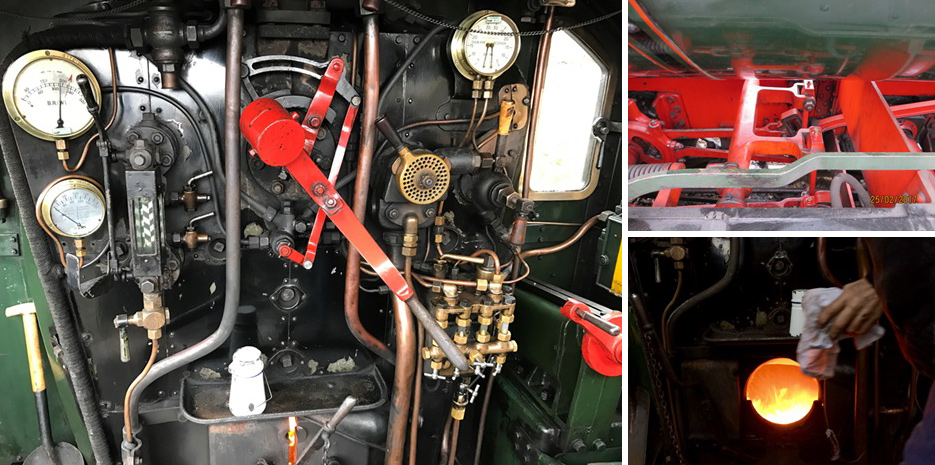
Erlestoke was spotted in the distance awaiting permission to enter the station, and instead of the usual single coach used for the introductory experience, a second matching ‘blood and custard’ was left attached from the previous days running, making for a more convincing train length (at least for those of us who grew up with tail-chaser Hornby sets). It’s hard not to be struck by how handsome the ex-Great Western locos are, but I also noticed a more well-earned patina on 7812 than I had noticed in previous years, in part because quite often there isn’t time to get that close to the engines during normal public services, especially when it’s raining, and Erlestoke is now in the final year before her overhaul. The driver Dai introduced the engine, explaining the typical usages of a Manor in mainline service, outlining the fundamentals of a Churchward / Collett 2-cylinder loco, highlighting the valvegear nestled between the frames before giving us a guided tour of the footplate. Fireman Ryan then took over explaining the firing duties. One thing that did surprise me that probably shouldn’t was the depth of the firebox. Reading about square-footage and despite the fact that the length of the firebox is inferred externally, I was still taken aback by how far forward the fire ran, the usual photos and videos don’t seem to really show this.
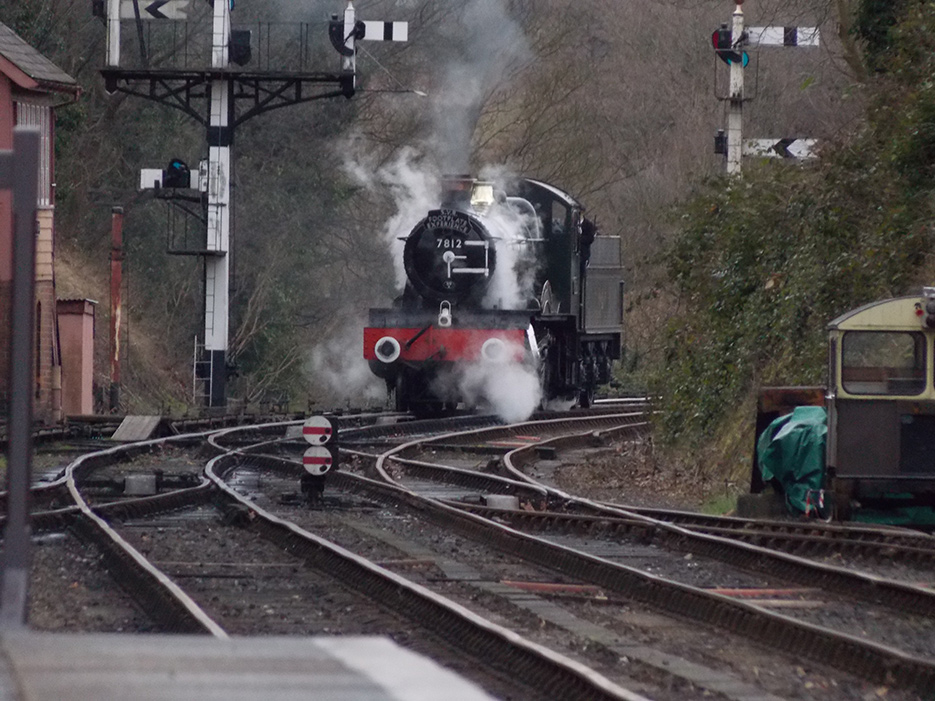
We then departed Bewdley and for the first stint I sat on the first carriage directly behind the engine with my guests, barely contained excitement given away by a set-like-concrete smile, and only a hint of nervousness, after all, the ‘real’ crew weren’t going to let me do anything wrong surely? Sooner than I thought, we arrived at Hampton Loade and appropriately ‘overalled’ and capped like a peaky blinder, it was my turn. My parents had turned up at the picturesque station with my 8-month-old son to see the event and capture photos and videos, and then finally I was at the controls.
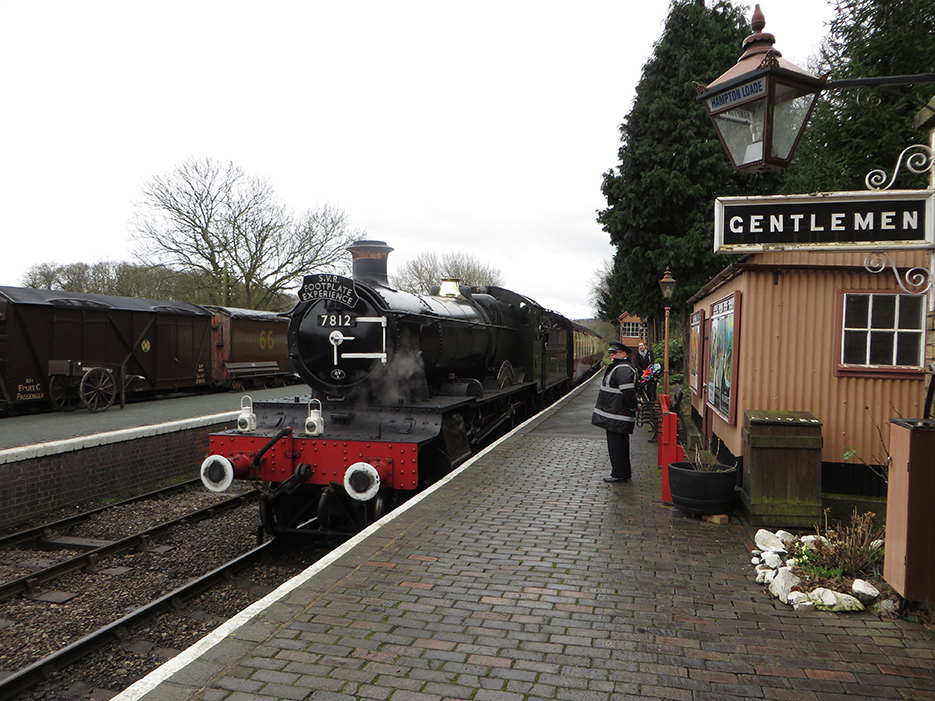
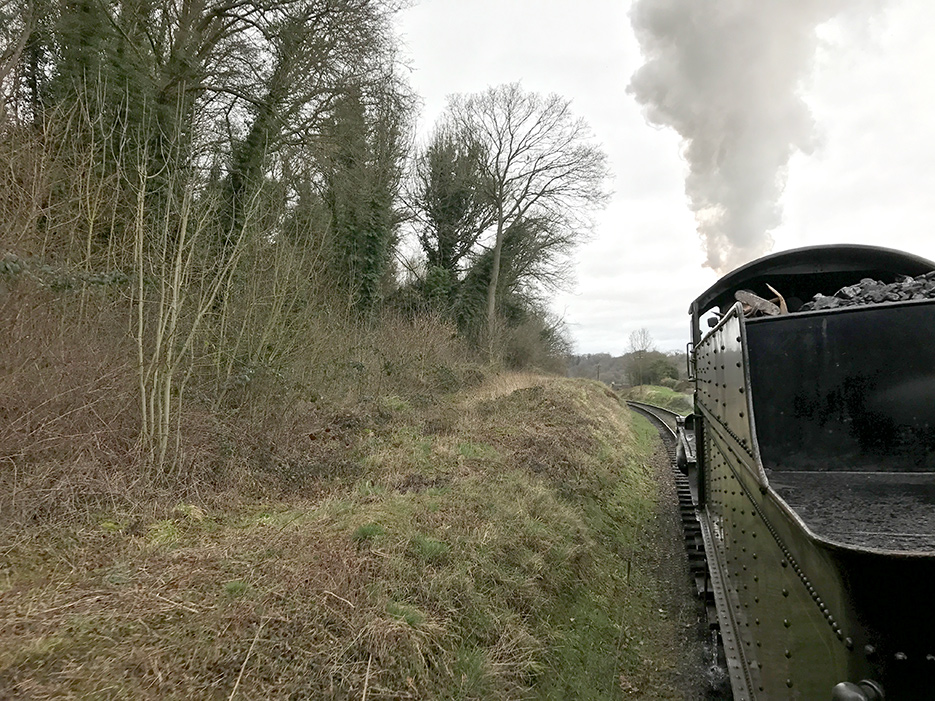
I took the first turn at driving, the simplified version of which meant recharge the vacuum to 25Hg for the brakes, wind the reversing gear to the full forward position and open the regulator, and just like that, we smoothly and strongly pulled away with nothing but a novice behind the controls, the Manor’s fine (erm,) manners and a light load doing much to flatter my own inexperience, and despite the very occasional hint of drizzle, the rails were dry. For the first half-a-mile or so it was actually surprising how on such a complicated machine, there was little that needed to be done, masking the enormous task of preparing the engine that had been ongoing since 5am and the that the actual crew had everything well under control. The reversing gear was wound back to allow the steam to work more expansively once in motion for efficiency, and then came a moment to soak it all in. After the initial assault on the senses, everything became very calm and I was able really appreciate the view. Looking through the ‘spectacle’ glass, staring down the tapered barrel of the boiler is a view every bit as evocative as the sculted bonnet of a Jaguar C-type or I imagine from the cockpit of a Spitfire. The main focus for the participant driver on an introductory experience is speed control, the detail of draughting, lubrication and draining the cylinders of condense when stationary was left to the experts Dai and Ryan. In advance you are warned about how much taller you stand in the cab, and that the loco’s movement on the rails is barely damped compared with the following coaches, but although these descriptions bring to mind a dinghy in storm, in reality there was little to be concerned with, the whole experience was very instinctive and all but the safety considerations of one’s location was forgotten once underway. The loco felt responsive and as though it had an awful lot of potential in reserve, which of course with only two sparsely populated coaches in tow and a preservation line imposed speed limit of 25mph, was exactly the case. I found myself envying the crew who guided me, who from feel and sound alone knew our velocity and knowing the track so well, where we’d need to build a little speed for inclines, but I was trusted to pick the right moments to reduce steam at the peak of a climb, and started to pick up the driver-side whistle signs without prompt. As with most incredible experiences, my first 4-miles on the footplate were over in before I could really take it all in and I slowed to a halt at the danger signal just before Bridgnorth station.
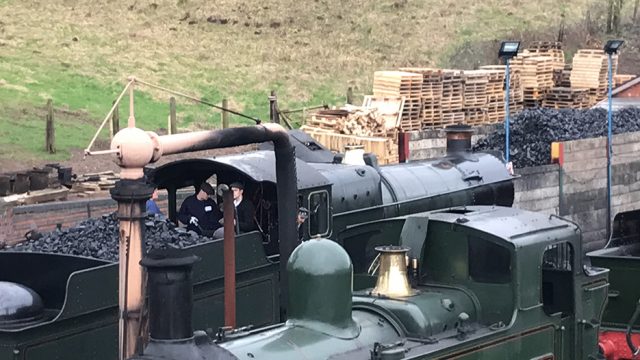
Due to some operational issues at Bridgnorth, we were waiting a while before the instruction came to disengage the loco from the train and take on water, and the exchange of tokens was a static affair. We moved to the water tower and also took on a bucket of coal, leaving the coaches where they stood on the line, and it was actually a Class 08 shunter that moved the coaches to the platform. It was a good time to have a chat with the rest of the crew including the fireman Ryan, and take a look at the 14XX Tank and the 28XX which was gleaming impressively. As it would now be my turn firing, the boiler was refilled with the live steam injector, and I built up the fire evenly ready for the uphill run out of Bridgnorth. We were eventually reunited with the train and set off tender first. This itself was quite an experience, you can’t quite be prepared for the view running backwards afforded by Erlestoke’s more original tender, as though on the bow of a ship, and with a headwind entering the cabin and the four of us on the footplate facing forwards standing near side-by-side, was another one of those moments that stays with you. You also learn quickly that you’ll need to grab onto your cap whenever you run under a bridge, that displaced cold air that previously could flow all around the train is suddenly forced over the tender and into the cab by the abutments and deck, leaving you grateful for the fire behind your back! Spare a thought for the original crews running backwards in the harshest of Welsh weather. Fireman Ryan commented I must have built a good fire as the pressure for the uphill run hovered reliably around 200 needing no further attention for some time, but this was a mix of beginner’s luck and more importantly excellent tuition. I had quite an easy time after than with just a few shovels here and there, and soon we were coasting back to Hampton Loade and came to a gentle stop, opened the water valve on the tender and injector, and that was my on the time up on the beautiful beast. On the return leg to Bewdley I could barely stop grinning from ear-to-ear.
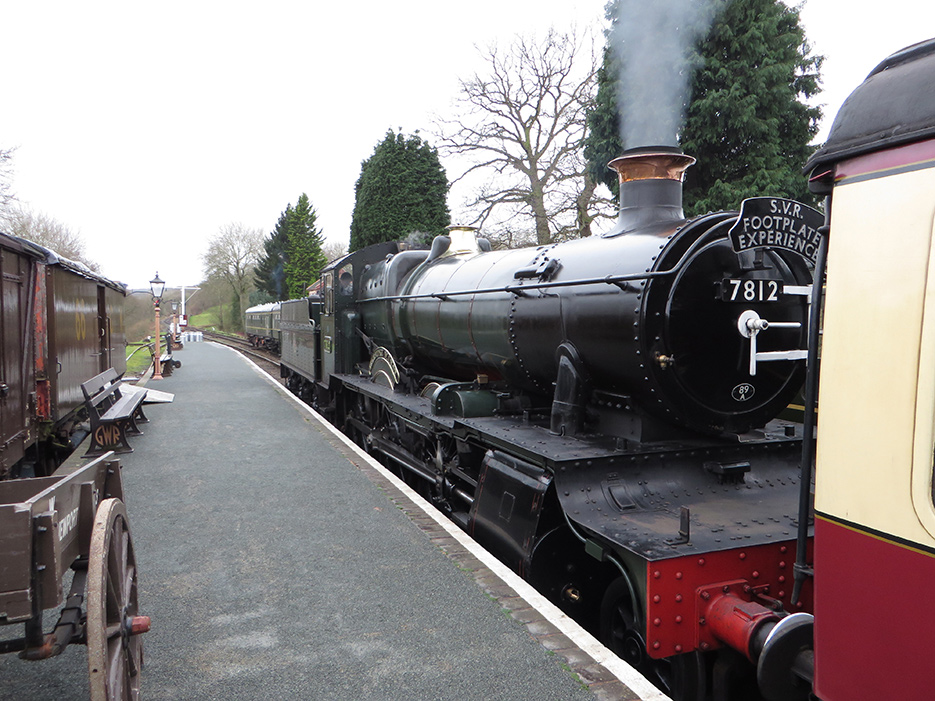
After departing the train, participants were presented with certificates, a unique mug and key ring to commemorate the day, but the incredible experience didn’t quite end there for the guests. With just enough time remaining, those who had had to stand back and watch, take photos and relegated only to the carriage for the journey were now invited onto the footplate to have a quick look around, something I thought was an extremely generous touch, but then it got even better, as the engine needed to be run-around the train at Platform 3. A small number of guests were invited back onto the footplate for the short trip and so my fiancée and two friends leapt at the opportunity. This took longer than expected when the signal south of the station remained at danger as a train led by 7714 took longer to depart than planned, this was absolutely fine for my guests who were warm and had a good chance to talk to the crew, including hearing about Ryan’s experience of being filmed by the BBC for the ‘Flying Scotsman From the Footplate’ documentary. When the signal finally cleared, Erlestoke sauntered to half way along platform 2, my guests stepped off, more photos were taken, and another participant’s guests were able to hop on for the final movement to the front of the Footplate Experience train ready for the next groups experience to begin.
The crew were absolutely fantastic, insightful, fun, and the SVR have gone to great lengths to keep the course sensible but light-hearted, it wasn’t a case of health and safety gone mad, and not a ‘jobsworth’ in sight. The experience is distilled to the highlights, the only negative aspect is perhaps that many of the guests won’t appreciate the hard work that goes into getting these locos ready early in the mornings and putting them to bed at night, and the volunteer army preserving the views alone the heritage line. Special praise must also be given to the long term members of the Erlestoke Manor Fund who are the very reason that these engines weren’t cut-up at the end of their first lives, and remain safe, reliable and enjoyable for future generations.
What an incredible privilege it was to spend the morning with 7812. I had hoped the experience would ‘scratch an itch’ and be the ultimate fulfilment for a steam enthusiast, but unfortunately it has only lit the fire, and I am desperate to do more. The price of experience can be somewhat prohibitive but I would absolutely recommend anybody with an interest to have a go, even just try the cheaper taster sessions, and take advantage of your EMF membership to get involved as much as you can in order to get close to these gorgeous engines.

